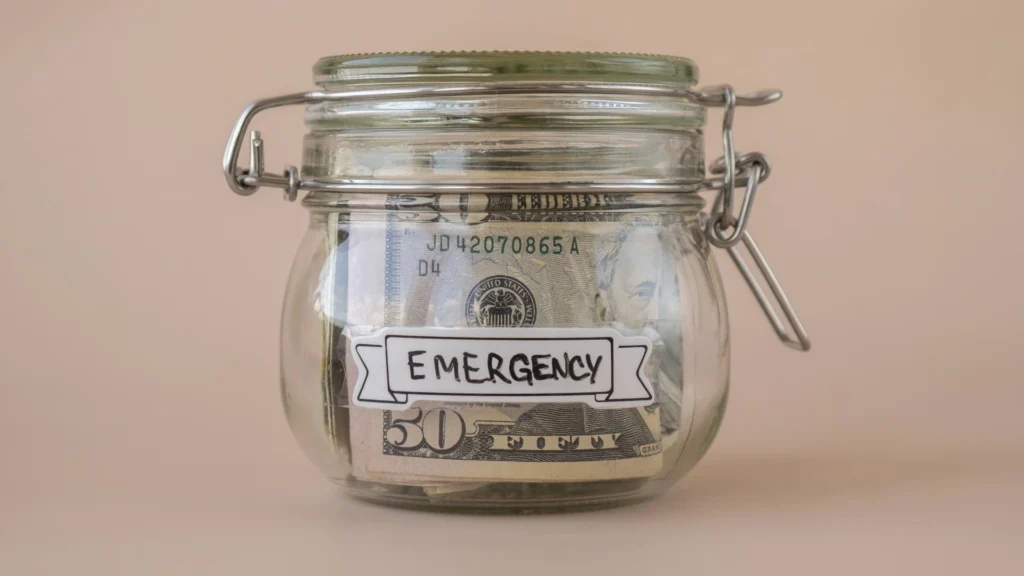Table of Contents
Emergencies happen: car breakdowns, sudden medical bills, urgent home repairs, or an unexpected travel need. The difference between an emergency that derails your finances and one you recover from is less about luck and more about systems.
This guide teaches a practical, humane approach to managing emergency expenses without overspending: how to decide whether something is a true emergency, quick steps to limit damage, safe short-term options, negotiation scripts, and recovery plans that stop one event from becoming a cycle of costly borrowing.
Throughout, you’ll get concrete checklists, sample numbers, a decision flow to use in the moment, and subtle, practical ways Beem’s Smart Wallet and Everdraft™ can act as tactical tools when you need them.
What counts as an emergency and why the definition matters
Emergency vs. urgent vs. avoidable expense
Labels change behavior. Use these working definitions:
- Emergency: A time-sensitive expense that threatens safety, income, shelter, or health (e.g., car repair that prevents commuting, urgent medical bill, burst pipe).
- Urgent: Needs attention soon but can be delayed a short time without major harm (e.g., a leaking faucet that can wait 48 hours).
- Avoidable expense: Wants or convenience purchases that feel urgent but aren’t (e.g., replacement TV the same day it breaks).
Why this matters: treating non-emergencies as emergencies causes overspending and reliance on high-cost credit. A short pause and a fast checklist will often reveal alternatives.
Quick litmus test for “true emergency”
Ask:
- Will this event immediately endanger health, shelter, or ability to earn?
- Will delaying 24–72 hours make the situation materially worse?
If the answer is “yes” to either, treat it as an emergency. If “no,” pause and plan.
Before an emergency: Build three simple layers of protection
1) Starter buffer (first line of defense)
- Goal: $500–$1,000. This is realistic to build quickly and prevents most small crises from turning into debt.
- How: Auto-transfer $10–$50 per payday into a labeled “Emergency” savings bucket.
2) Medium buffer
- Goal: 1–3 months of essentials (rent/mortgage, utilities, food, transport).
- How: Use sinking funds and small weekly automation to reach this over time.
3) Access & planning
- Keep a list of trusted repair shops, nonprofits, and community resources.
- Keep documents (insurance, warranties) accessible so you don’t miss coverage that pays.
These layers reduce dependence on expensive fixes and give you options when the unexpected happens.
In the moment: A 7-step emergency decision checklist
When something breaks, move quickly, but calmly. Use this checklist to avoid costly panic spending.
- Pause for 15 minutes. Don’t open a loan app yet. Breathe.
- Assess severity with the litmus test. Safety/income/shelter = emergency.
- Estimate the cost range. Call one local shop for a quick quote or use an online estimate. Get 2–3 quick numbers.
- Check immediate sources: Starter buffer, available checking balance, credit card with low rate, community supports, warranties, or insurance.
- Consider low-cost alternatives: DIY fix, delayed service, ride-sharing instead of car repair same day.
- If you must borrow, compare options quickly (see comparison table below). Favor the cheapest, least damaging choice.
- Record the decision and repayment plan immediately. If you borrow, set an automatic repayment transfer or a short-term repayment schedule.
This checklist prevents instinctive, expensive choices and gives you a recovery plan.
Quick comparison: Short-term options
| Option | Typical Cost / Drawback | When to pick it | Smart use-note |
| Starter buffer | No cost | Best first choice | Refill it next pay cycle |
| Low-interest credit card | Interest charges if not paid | Good if paid within card grace period | Use only if you’ll pay balance quickly |
| Personal loan / credit union loan | Lower interest than payday loans | For larger, planned emergencies | Shop rates and term |
| Everdraft™ (Beem) | No interest advance (limited terms) | Short-term cash bridge for urgent gaps | Use only as bridge + set repayment plan |
| Payday loan / cash advance apps | Very high fees/interest | Avoid if possible | Last resort — seek alternatives first |
| Borrow from family/friend | No/low interest but personal cost | Quick bridge if terms clear | Put repayment plan in writing |
| Payment plans with provider | Often free or low fee | When available (medical, auto shop) | Ask—many providers offer options |
Use the cheapest credible option that you can realistically repay in the short term.
Negotiation scripts and strategies to lower costs now
You can often reduce the bill immediately. Call, ask, and pause.
Auto/repair or contractor script
“Hi — I need a sense of urgency and options. Can you give me a quick estimate for the repair, and tell me if there’s a lower-cost fix or a payment plan? Also, do you offer any discounts for cash or for scheduling during a quieter day?”
Medical bill script
“Hello, I received bill #_____. I’m uninsured / underinsured (or insurer hasn’t paid yet). Do you offer a hardship discount, sliding scale, or payment plan? I can pay $X today and $Y/month if that helps.”
Utility / landlord / service provider script
“I’m facing an urgent bill this month. Are there short-term assistance programs, deferred payment plans, or community grants you can connect me with? I want to avoid shutoff/late fees.”
Scripts work because businesses and providers often prefer negotiated payment to non-payment or collections.
When borrowing: Build a one-page repayment plan immediately
If you take an advance or loan, document three things and automate them:
- Total owed (including fees).
- Target repayment date (no more than 2–6 months for small advances).
- Automated transfer amount each pay period and date.
Example:
- Borrowed: $600 (Everdraft™)
- Plan: Repay over 6 paychecks → $100 per paycheck auto-transfer into repayment account.
Automation reduces the temptation to delay and makes recovery predictable.
Avoid these common traps that create cycles of debt
- Repeated small payday loans: each one creates fees and time-consuming repayment.
- Using credit cards for ongoing expenses: if you’re covering recurring bills with credit, stop and build a plan.
- No follow-up after repairs: not filing warranties or not checking insurance often loses recoverable funds.
- Not tracking the impact: failing to record the emergency destroys your budget visibility; track it, then plan.
A one-time emergency becomes a crisis when you do nothing after it’s over.
Repair vs replace: Decision guide to save money
When something breaks, decide whether to repair or replace.
Quick rule of thumb
- If repair cost < 50% of replacement cost and item expected to last as long or longer after repair → repair.
- If repeated repairs in the last year, or the item is obsolete, consider replacement.
Examples
- Car: If repair is minor and keeps you working → repair. If major engine work equals >50% of car value → consider replacement options.
- Appliance: If under warranty or repair <50% of replacement and appliance is fewer than 7 years old → repair.
- Phone: cracked screen repair often cheaper than replacement, but if battery and other issues pile up, replace.
This thinking prevents emotional overspending on new purchases.

Post-emergency: Recovery plan to stop repeat events
- Rebuild the starter buffer immediately. Make the next 4 paychecks include an extra $25–$100 for rebuilding.
- Log and categorize the expense. Put it into your budget app as “Emergency — [type]” and capture what triggered it.
- Set preventative actions. Example: if car broke due to deferred maintenance, schedule routine checks and budget for them.
- Review insurance and warranties. Did coverage exist? Was it used? Could different coverage make sense?
- Adjust savings rules. If the emergency came from a predictable risk (seasonal storm damages), add a dedicated sinking fund.
Recovery is not just paying back debt — it’s learning and changing systems so the next shock is smaller.
Using Beem’s Smart Wallet and Everdraft™ responsibly (subtle, tactical)
Beem’s tools are designed as tactical aids, not long-term solutions.
Smart Wallet: Prevention and clarity
- Auto-categorizes spending, flags upcoming bills, and forecasts low-cash windows. These signals often let you act before an emergency becomes critical (move payment dates, defer non-essentials, or arrange short-term help).
- Use Smart Wallet insights to identify the root cause (e.g., seasonal car costs) and pre-fund a sinking fund.
Everdraft™: A responsible bridge, not a habit
- Everdraft™ provides instant access up to $1,000 with no interest and no credit checks for qualified users — useful if you have a true emergency and no other low-cost options.
- If you use Everdraft™, create the one-page repayment plan immediately and automate repayments. Treat it like a loan to be cleared quickly so it remains a safety net, not a funding source.
The right tech makes emergencies manageable; the wrong habit makes them recurring.
Community and non-lending resources to check quickly
- Local nonprofits, churches, and community action agencies often have emergency assistance for utilities or rent.
- Employer or union emergency funds sometimes exist — ask HR quietly.
- Crowd-based options: ask trusted friends/family for a short-term bridge with clear terms.
- Manufacturer warranties, home warranty plans, or extended insurance can sometimes be retroactive if you filed within a window.
Always compare the cost and speed of help; community aid is often low-cost but may have administrative lag.
Sample scenarios — what to do, step-by-step
Scenario A: Car breaks down and you need to get to work today
- Pause 15 minutes, call two local mechanics for quick quotes.
- If repair < starter buffer, pay and schedule. If > buffer, ask the mechanic for a phased fix or temporary repair to get you to work.
- Check Everdraft™ availability and compare it with credit card cost. If Everdraft™ bridge is cheapest and repaid within a few paychecks → use it with automated repayment.
- Rebuild buffer and set a maintenance schedule.
Scenario B: Unexpected urgent medical bill
- Confirm whether insurance or provider billing error exists.
- Ask the provider for a hardship discount or a payment plan. Use scripts.
- Consider the Beem app’s Everdraft™ instant cash advance only if the provider won’t accept a plan and fees/penalties loom.
- Apply for hospital financial assistance programs if eligible.
These concrete steps reduce panic and costly mistakes.
Measuring success: Metrics to track after an emergency
- Buffer rebuilt: Days or months until the starter buffer is restored.
- Debt paid down: Remaining balance of any emergency borrowing.
- Fees avoided: Number of overdraft or late fees prevented by the decision.
- Stress reduction: Subjective, but ask yourself monthly: “On a scale of 1–10, how worried are we about money?” (Track trend)
Small wins compound into real resilience.
FAQs on Managing Emergency Expenses Without Overspending
When is it actually smarter to use a credit card instead of a short-term advance?
Use a credit card if you can realistically pay the balance within the interest-free grace period (typically 30–60 days) or if the card’s interest rate over your intended repayment period is lower than other options. Compare fees, and avoid carrying high balances that accrue interest over months.
What if I don’t qualify for Beem’s Everdraft™? What then?
If Everdraft™ isn’t available, prioritize non-loan options: starter buffer, negotiating with providers for payment plans, borrowing from a trusted friend/family with clear terms, or a small personal loan from a credit union. Avoid payday loans and high-fee cash advances.
How fast should I rebuild my emergency buffer after using it?
Rebuild as fast as your cash flow reasonably allows without causing new stress. A good goal: restore the starter buffer ($500–$1,000) within 1–3 months by adding a modest automatic transfer each paycheck (e.g., $25–$100). For larger emergencies, aim to rebuild within 6 months while paying down any associated debts.
Final checklist: Immediate and 30-day actions after an emergency
Immediate (within 48 hours):
- Use the 7-step checklist; pick the cheapest viable funding option.
- Negotiate the bill; ask for a payment plan or discount.
- If borrowing, create a one-page repayment plan and automate transfers.
30-day follow-up:
- Rebuild starter buffer with automated transfers.
- Add a preventive item to your maintenance calendar (car service, home inspection).
- Log the event in your budget and adjust sinking funds or insurance if needed.
- Review whether a different insurance or preventive plan would have reduced risk. Consider changes.















































